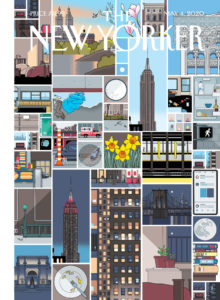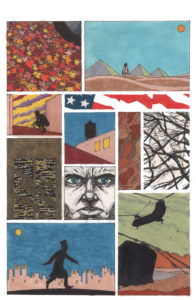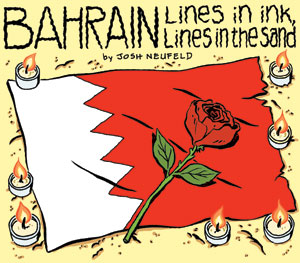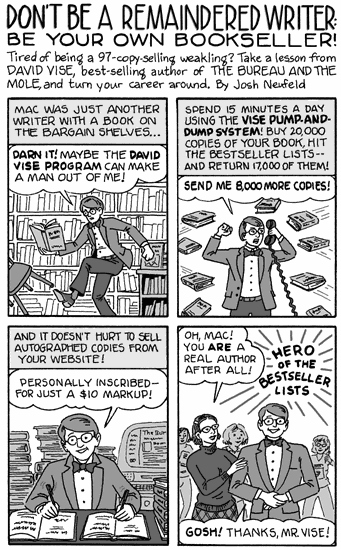When I saw this week’s cover of The New Yorker, “Still Life,” by cartoonist Chris Ware, I was immediately reminded of a comics piece I had drawn nearly 30 years ago. Chris’ cover is a multi-panel non-narrative portrait of New York City under coronavirus lockdown. My piece, from the fall of 1991, is a multi-panel non-narrative portrait of the U.S. in the aftermath of Operation Desert Storm (the first Gulf War).
The origins of my piece stem from a period when I was first starting to think about different ways I could use the comics form. Up to that point, pretty much all I had ever drawn were superhero-style comics, but I was losing interest in the genre and I was confused about what other possibilities there were for the form. So this piece, which is untitled, came out of that search.
The page mostly features familiar motifs of the first Gulf War era — camouflage, American flags, military helicopters — and some signs of the season — bare tree branches, fallen leaves. But it also has other more fanciful features. It’s like an impression of a certain time — in the life of the city, and in the psychology of a young man of that era.
One of the most striking similarities between the two pieces are images of New York City’s iconic skyscrapers in the page’s lower-left areas: Chris’s portrait of the illuminated Empire State Building at night, and my portrait of the towers of the World Trade Center, shrouded in fog. (If you are darkly sentimental, it’s easy to imagine those are the towers surrounded by the smoke of their own destruction on 9/11 — still some 10 years in the future.)
It just so happens that I know Chris Ware. We met in Chicago a few after I drew this piece, through a mutual friend, and our occasional get-togethers were very meaningful for me as an aspiring “alternative cartoonist.” Chris was always encouraging to me, and he taught me a lot about the practice of comics; and it was fun getting together with him and his wife Marnie.
Before you ask, he definitely never saw my non-narrative comic, and it has never been published — or until now, even publicly exhibited. I was just struck by the two piece’s superficial similarities.
(By the way, I colored the piece directly on the page with Design markers — probably the last time I ever used markers of any kind on my comics. Pre-PhotoShop!)
P.S. My very astute wife points out that Chris’s piece is very clearly NOT non-narrative (now that’s a confusing sentence). If you “read” it left-to-right, top-to-bottom, you realize that the story progresses through a day from morning to evening, and much of it is from the perspective of one person stuck in their apartment. There’s so much more to his piece than just an aspect-to-aspect series of images. Proof once again that Chris Ware is a genius!!



 This coming
This coming 
 Did you see
Did you see 
